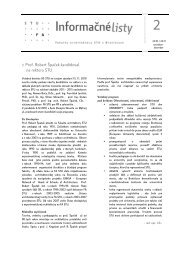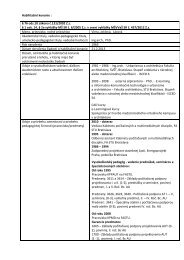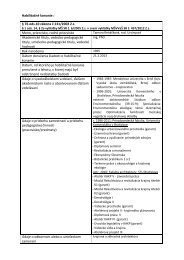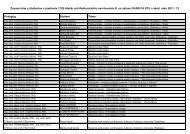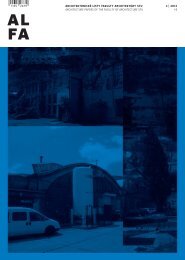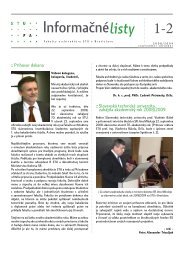ALFA 3-4/2005 - Fakulta architektúry STU
ALFA 3-4/2005 - Fakulta architektúry STU
ALFA 3-4/2005 - Fakulta architektúry STU
You also want an ePaper? Increase the reach of your titles
YUMPU automatically turns print PDFs into web optimized ePapers that Google loves.
Ročník 9<br />
3-4 / <strong>2005</strong> ARCHITEKTONICKÉ LISTY FA <strong>STU</strong><br />
Touch<br />
Touch is known as the confirmatory sense. By touching, we<br />
confirm what we pick up from our other senses, which are what we<br />
see, hear, smell or taste. The skin is the largest sensory organ.<br />
Touch collects information and confirming data received by<br />
the other senses. It is the haptic sense of living and acting in space.<br />
Textural surfaces form an integral part of a child’s world of<br />
learning. They can help a partially sighted patient to navigate<br />
through space, imagine a blind person’s total environment, and<br />
support a mental health patient’s shift from an unreal world to<br />
reality. Patients with sensitive burnt, cut, bruised or blistered skin<br />
will experience their environment with their feet, elbows, backs,<br />
bottoms, lips, noses etc. as well as their hands.<br />
Useful: Touch is particularly important to people with visual<br />
impairments. Tactile floor and wall surfaces can be used to convey<br />
important information about their environment. Changes in texture<br />
can also warn of potential hazards or provide directional<br />
information. Children need tactile experience to develop their<br />
sensory receptors. Where possible, designers should introduce<br />
textured surfaces, which can create an integral part of a child’s<br />
play and learning process. This is a useful tool for a child’s<br />
developing sensory receptors.<br />
Comfort: The careful specification of varied texture and tactile<br />
surfaces is necessary. It introduces interest, variety and comfort<br />
and assists in wayfinding for visually impaired people. Furnishings<br />
should be selected with comfort in mind, for example soft<br />
bedcovers, fabrics, rounded corners and ergonomically designed<br />
furniture. Placing controls for nurse call, lighting, telephone,<br />
television, and radio within easy reach of a patient enhances selfreliance<br />
and increases patient safety. In multi-bed rooms, each<br />
patient should also have equal access to controls such as<br />
windows, blinds, curtains and television. An environment scaled<br />
for young children and elderly or disabled people will enhance<br />
their sense of independence.<br />
Harmful: Very careful attention should be paid to the detailing<br />
of furniture and fittings. The design should minimise the risk<br />
of users trapping their fingers and toes etc. Where possible sharp<br />
corners should be avoided and redesigned to prevent predictable<br />
injury. Furniture that can’t be moved may cause patients to feel<br />
stressed or anxious and may contribute to a patient’s sense<br />
of helplessness and dependence. Fixed tables and chairs should<br />
be avoided where possible.<br />
Smell<br />
In hospitals, medicinal smells can produce anxiety. Unpleasant<br />
odours increase heart rate and respiration. One forgets that some<br />
of the smells that inhabit hospitals are formaldehyde, formulin,<br />
iodine, glutaraldehyde, bone dust, urine, burnt skin, testosterone,<br />
disease, body odour etc. Fear is communicated through smells.<br />
Good ventilation systems and appropriate building’s layout are<br />
- 37 -<br />
sufficient to eliminate odours and smells but we have to pay<br />
attention to these factors from beginning.<br />
Taste<br />
Today’s dining spaces can be clinical and sterile spaces delivering<br />
regenerated and hermetically sealed food sustenance. Young<br />
children will pop anything in their mouths. They may drink bath<br />
water, suck plugs, eat crayons and swallow other small objects.<br />
Teething infants sometimes find relief in licking the glass on<br />
windows and mirrors, and biting stainless steel handles and other<br />
cold surfaces. Children may lick and chew furnishings. Designers<br />
must check the toxic nature of materials during specification and<br />
avoid products containing formaldehydes, wood preservatives,<br />
arsenic, white spirit, benzene and other toxic substances.<br />
Hearing<br />
Sound has a fundamental effect on us, both psychologically and<br />
physiologically. Sounds such as rain, a breeze, the sea, moving<br />
water and songbirds can calm and create a sense of wellbeing.<br />
Courtyards and landscaped gardens close to patient areas should<br />
include plants that encourage songbirds.<br />
Music can have an analgesic or painkilling effect, and can also<br />
reduce blood pressure, heart and respiration rates. Patients<br />
should have the opportunity to listen to music via headphones and<br />
live performances. It is important to remember that some people<br />
will view music as noise. Therefore, people should have a choice<br />
as to whether they have to listen to music. Music therapy is used<br />
to treat depression, to reach autistic children and to calm and relax<br />
agitated psychiatric patients.<br />
Reduce patients stress and improve outcomes<br />
Increase staff effectiveness by designing better workplaces<br />
Jobs by nurses, physicians, and others often require a complex<br />
choreography of direct patient care, critical communications,<br />
charting, filling meds, access to technology and information, and<br />
other tasks. Nurses, physicians, and other healthcare employees<br />
work under extremely stressful physical conditions. Many hospital<br />
settings have not been rethought as jobs have changed, and, as<br />
a result, the design of hospitals often increases staff stress and<br />
reduces their effectiveness in delivering care. There is a growing<br />
and convincing evidence suggesting that improved designs can<br />
make the jobs of staff much easier.<br />
Nurses spend a lot of time walking. According to study<br />
McCorick&Scheve, (1990), almost 28.9 percent of nursing staff<br />
time was spent walking. This came second only to patient-care<br />
activities, which accounted for 56.9 percent of observed<br />
behaviour. The main factor, which influences amount of walking<br />
among nursing staff in hospital, is type of unit layout (e.g. radial,<br />
single corridor, double corridor).



